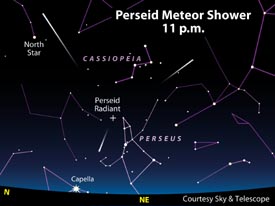From SkyandTelescope.com:
The Perseid meteor shower peaks this year when there’s almost no Moon, affording a dark sky for late-night shooting-star spectators and counters. A thick waxing crescent Moon sets in mid-evening, so it will offer little interference for this year’s event.
 Earth should go through the densest part of the stream for some hours on August 12th around 19h Universal Time, which is 3 p.m. Eastern Daylight Time. This means the shower’s peak splits the difference between the early-morning hours of August 12th and 13th for anyone in North America or Europe. So the number you count on each of those mornings, even in ideal conditions (no light pollution and the radiant nearly overhead) might not match the International Meteor Organization’s predicted peak of 100 per hour. But surprises can always happen.
Earth should go through the densest part of the stream for some hours on August 12th around 19h Universal Time, which is 3 p.m. Eastern Daylight Time. This means the shower’s peak splits the difference between the early-morning hours of August 12th and 13th for anyone in North America or Europe. So the number you count on each of those mornings, even in ideal conditions (no light pollution and the radiant nearly overhead) might not match the International Meteor Organization’s predicted peak of 100 per hour. But surprises can always happen.
Perseid meteors can appear anywhere in the sky, but they appear to stream outward from a spot (called the radiant) in the constellation Perseus.
Some Perseids appear beginning around 9 p.m., but they’re always better from about 11 p.m. or midnight until the first light of dawn. This is when the shower’s radiant point in northern Perseus climbs high in the northeastern sky. Or, to put it another way, this is when your side of Earth turns to face the oncoming meteor stream more directly.
Get the rest of the story here: Get Ready for the 2013 Perseids